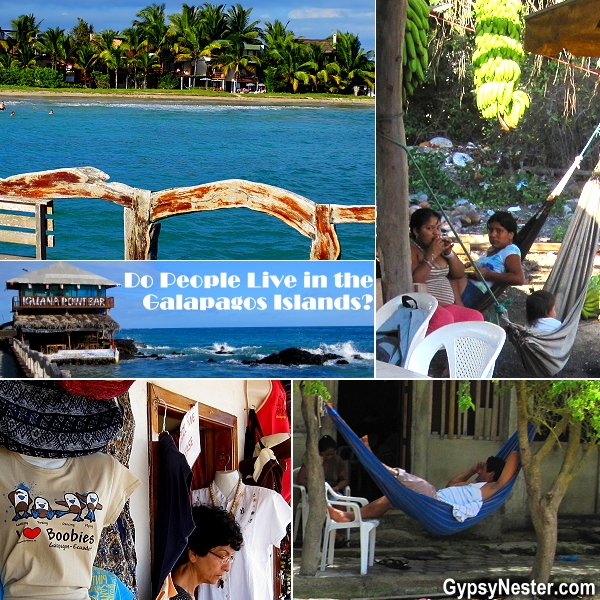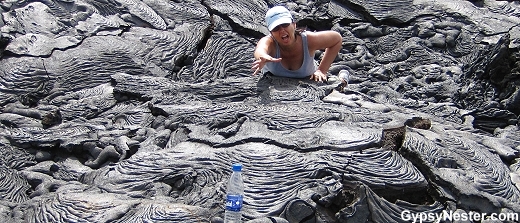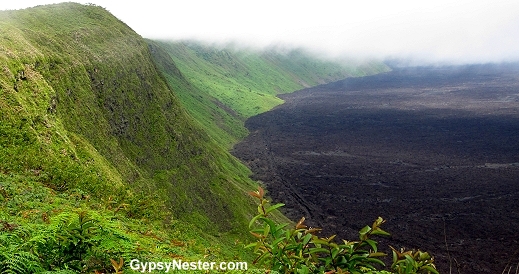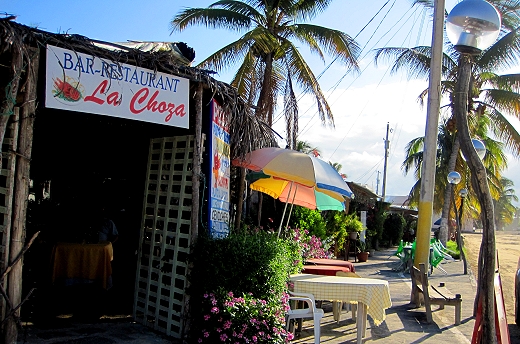
Say Galapagos and what pops to mind? For us, no doubt as for many folks, it was the image of giant tortoises.
They may well be the most famous attraction of these islands, but birds run a close second to the huge reptiles, with boobies of the blue footed, red footed and Nazca varieties being nearly as renowned.
Seeing these iconic symbols of this equatorial archipelago was definitely a bucket list-worthy highlight of our trip, but swimming in tropical waters with penguins and sea lions…
…or watching an albatross soar overhead, or standing on a fresh lava flow surrounded by thousands of marine iguanas made for equally memorable moments.

Some were unexpected, such as pink flamingos, or the stark, volcanic landscape of several of the islands, but perhaps our biggest surprise was discovering that the creatures immortalized by Darwin share these islands with thousands of people.
We found not only the expected curious visitors such as ourselves, but also permanent residents of this remote outpost in the Pacific.

Obviously a few people are needed to fill the necessary posts involved with the arrivals and departures of airplanes and ships from the mainland, but there are over twenty-five thousand permanent citizens of the Galapagos.
The history of these inhabitants began when pirates and whalers used the islands as a base for fresh water and supplies as far back as the early 1500s.

By 1835, when Charles Darwin visited on the voyage of the Beagle, the population was large enough to warrant a governor, mostly supporting a prison colony. Over the next century a few more hardy settlers arrived to try their hands at fishing or farming.
Later, with the outbreak of World War II, the population swelled as the location of the islands took on strategic significance for protecting the Panama Canal.

After negotiating a deal with Ecuador, the United States built the Seymour Island Airfield for the Army Air Force and a naval base, providing infrastructure that made travel from the mainland much easier.
The island is now known as Baltra, but the airport is still in use today for commercial and private aircraft.

While it can handle large jets from South America (we flew in from Quito), it is not near any city.
We only saw a smattering of dwellings and open-air gift shops when we made our way from the plane to our boat at the nearby docks, so we were still under the impression that the Galapagos were virtually uninhabited.

It wasn’t until several days later, when we visited Isla Isabela, that we discovered our assumption was incorrect. After hiking to the top of Volcán Sierra Negra and peering over the rim of the active volcano…

…we made our way down to the Giant Tortoise Breeding Center of Isabela. From the Center, we followed a boardwalk trail toward the seashore.
The walkway through the wetlands was yet another wildlife wonderland, passing a variety of habitats for birds, including a salt water lagoon filled with a flock of flamingos.

Just beyond that a group of marine iguanas had taken to the path for some sunbathing.

We were surprised when the trail ended in the quaint tropical village of Puerto Villamil, but after miles of hiking we were more than pleased to find this outpost of civilization.

Click here for our entire adventure in The
Galapagos

Before any further exploration, we plopped down in an open-air cantina called La Choza and proceeded to wash down the trail dust with a chilled Cerveza Pilsner – Ecuador’s most popular brew.
Refreshed, we took in the town, which didn’t take too long because even though it is one of the larger human-inhabited places on these islands, it is only home to about a thousand people.


Most full time residents of the Galapagos live in the towns of Puerto Ayora on the Island of Santa Cruz, or Puerto Baquerizo Moreno on Isla de San Cristóbal.
Our boat bypassed both of those islands, so our only experience with civilization was at Puerto Villamil.

Traditionally the town has been a fishing port, but in recent years it has become a favorite anchorage for private sailors, especially those headed on to the South Pacific.
Once we had strolled around the main square, and viewed the large, water-inspired church…

…we gravitated toward the water, as we usually do.


On the beach we found the Iguana Point Bar, a classic seaside watering hole, and grabbed a spot overlooking the ocean.
It didn’t take long to notice that we had company, some little visitors who made it clear that the establishment’s name was fitting.

Unlike their green cousins, marine iguanas are all grey and have adapted to where they can swim like Mark Spitz.
This allows them to feed on aquatic plants, even under the surface.
Speaking of Spitz, their adaptations also include the ability to filter the salt out of sea water, so they periodically spit, or more precisely sneeze, out the excess salt.
10 Second Video: Look fast! This guy is clearing the salt from his head after a swim!
Click here for our entire adventure in The
Galapagos

Fortunately, or perhaps unfortunately, we got a really good look at this process since our little visitors were not the least bit concerned about their close proximity to us humans.
That is a huge part of the attraction of these islands. The animals are so well protected that they have no need to fear us.
We saw this again aboard our dinghy as we were leaving Puerto Villamil behind. A sleepy sea lion had climbed up on the bow of a fishing boat for an afternoon nap without the slightest concern about the presence of people.
This wasn’t always the case; early visitors hunted some of the tortoise species to extinction, and also introduced some very intrusive nonindigenous critters such as goats and pigs.
These domesticated farm animals caused great havoc when they escaped and formed feral populations that compete with the native creatures for food and habitat.

Happily, over the past few decades the Ecuadorian government has implemented strict controls and programs to reverse the damage, and they are having a very positive effect on the islands’ fragile ecosystem.
So while we learned that thousands of people live here, and even more come to visit, steps are constantly being taken to limit their impact on the environment.

The plan is for the Galapagos to remain a unique and extraordinary place, not only for today’s residents and visitors, but for many generations to come.
David & Veronica, GypsyNester.com
Click here for our entire live-blog of our adventure in The
Galapagos
Delve deeper:
Check out the landscape of The Galapagos
Cavort with Sea Lions!
The Birds of The Galapagos – wild!
The Underwater World of The Galapagos
People live in the Galapagos?
Our tips for visiting The Galapagos Islands – including what to pack
YOUR TURN: Are The Galapagos Islands on YOUR bucket list? Have we inspired you to go?







Interesting! What an endlessly fascinating place.
So true Karlie.
That’s interesting – I’d never realised that anyone lived on Galapagos. I love the wildlife pictures, perhaps I’ll get there myself one day.
Thanks Karen, hope you do!
I had an iguana I thought was dead “sneeze” on me and did not enjoy it! I bought a beautiful woven basket in one of those towns and was also surprised that there were human inhabitants who were not researchers or guides or somehow involved in maintaining the islands or controlling the tourism. It’s really a place to try to get to once in a lifetime – loved it and your picture brought it all back – thanks!
It is certainly a bucket list destination.
What an incredible place! Your photos are fantastic, most enjoyable read as well. I knew there had to be some people living in the Galapagos Islands but I wouldn’t have guessed 25K people! Galapagos Islands are place I have yet to visit but certainly plan to go.
Thanks Susan. Highly recommend a visit.
I did know that there was a sizable human population on the Galapagos, and I enjoyed your take. The iguana sneezing is a factoid I won’t be able to get out of my brain. Hopefully, we will have a chance to visit one day.
Hope you do too Betsy.
We loved our time in the Galapagos Islands last fall and considered it one of the high points of our time in Ecuador. Like you, we were also surprised to find towns with people who had lived there for generations. And what an amazing place to call home!
I think most people think no humans live in the Galapagos. I knew that they do, mainly because of an interesting movie I saw recently. You might enjoy it, too. The Galapagos Affair: Satan Came to Eden
Thanks for the tip Carole. We’ll look for it.
What a fascinating perspective you took for this story! Nice that the human touch remains in the background~
I love that image of the sea lion peacefully sunning himself ( or herself) on the boat. Puerto Villamil looks like a beautiful place to visit! Kudos to the government of Ecuador for preserving it.
Now THAT would be quite the place to live. Wonderful pictures.
Thanks Charles!
I learned at least two things I didn’t know from this post: that you can fly to the Galapagos and that people live there. I thought they were desolate and that the only way to get their was by boat. I don’t do boats so this is great news. It can now be added to my ever-growing list.
We were under that impression ourselves.
The things I’ve read about Galapagos Islands focused on the fauna. It was interesting to read a little bit about the people and the history. A fascinating place.
We found so many things intriguing about the islands.
Yet more reasons to inspire us to get our behinds to the Galapagos. It is creeping up ever closer to the top of our mutual bucket list. (We also have to have separate bucket lists because Mr. Excitement has exactly zero interest in going to Antarctica or doing an RV road trip.)
The Galapagos can and should be near the top of everyone’s list… (no matter how exciting). 😉
This may seem intrusive, but a ballpark on cost and length of stay on this bucket-list worthy adventure would be solid information, if only to dream of.
Who knew? This is awesome! All the more intriguing- looking forward to visiting someday.
It’s near the top of our list of best places ever!